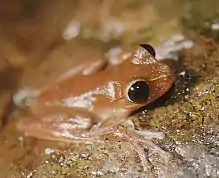| Australian lace-lid | |
|---|---|
 | |
| Scientific classification | |
| Domain: | Eukaryota |
| Kingdom: | Animalia |
| Phylum: | Chordata |
| Class: | Amphibia |
| Order: | Anura |
| Family: | Hylidae |
| Genus: | Ranoidea |
| Species: | R. dayi |
| Binomial name | |
| Ranoidea dayi (Günther, 1897) | |
 | |
| The range of Nyctimystes dayi. | |
| Synonyms | |
| |
The Australian lace-lid (Ranoidea dayi), also known as lace-eyed tree frog and Day's big-eyed treefrog, is a species of tree frog in the subfamily Pelodryadinae. It is endemic to the wet tropics of north-eastern Queensland, Australia.
Description
This is a small to medium-sized frog growing up to 50 mm (2.0 in) in length. The dorsal surface is rich-brown to orange-brown with or without scattered cream or lichen-like spots and blotches covering it, the head or the limbs. The arms and legs have faint barring and a slight fringe along the outer edges. The belly is cream-white and granular, with the throat and under surface of the arms and legs being black. The iris is dark brown and the pupil is vertical when constricted. The lower eyelid is patterned with lines, veins, and dots which give the frog its name. Toes are fully webbed and fingers are almost completely webbed. The tympanum is distinct with the upper quarter cover under a skin fold.[3]
Common names for R. dayi include Australian lace-lid, lace-eyed tree frog, and Day's big-eyed treefrog.[1]
Ecology and behaviour
This species ranges from Paluma to Cooktown in northern Queensland. It is associated with fast-flowing creeks in montane rainforests of altitudes ranging from 0–1,200 m (0–3,937 ft). But can also be found around slower watercourses and rock soaks when ample vegetation is present.[1] They breed from spring to summer with peak breeding occurring from October to April. Males call while on low foliage or rocks close to the stream, and have has two distinct calls. A drawn-out "eeeeeeee" repeated three or four times in concession is made when calling in a group and when calling alone a short "ee" is made every 4–5 seconds. Eggs are large and unpigmented and are laid in clumps of up to 100 attached to submerged objects.[3]
Similar species
It may be confused with the fringed tree frog, which is readily distinguished by the vertical pupil and the lower eyelid patterning.
Conservation status
As of August 2023 the Australian lace-lid is listed as an endangered species under the IUCN Red List and as vulnerable under the Commonwealth EPBC Act and Queensland's Nature Conservation (Animals) Regulation 2020.[1]
A study published in Biological Conservation in March 2023 listed 23 species which the authors considered to no longer meet the criteria as threatened species under the EPBC Act, including the Australian lace-lid. The reason for their assessment was given as "Populations now stable or increasing, following previous rapid and severe decline".[4] The team, led by John Woinarski of Charles Darwin University looked at all species listed as threatened under the act in 2000 and 2022,[5]
References
- 1 2 3 4 "Litoria dayi — Australian Lace-lid, Lace-eyed Tree Frog, Day's Big-eyed Treefrog". Species Profile and Threats Database. Department of Climate Change, Energy, the Environment and Water, Australian Government. 2023. Retrieved 23 August 2023.
 Text may have been copied from this source, which is available under a Attribution 3.0 Australia (CC BY 3.0 AU) licence.
Text may have been copied from this source, which is available under a Attribution 3.0 Australia (CC BY 3.0 AU) licence. - ↑ Jean-Marc Hero; Ross Alford; Michael Cunningham; Keith McDonald; Richard Retallick (2004). "Litoria dayi". The IUCN Red List of Threatened Species. IUCN. 2004: e.T14969A4484777. doi:10.2305/IUCN.UK.2004.RLTS.T14969A4484777.en. Retrieved 10 January 2018.
- 1 2 "Nyctimystes dayiAustralian Lacelid". Frogs Australia Network. 23 February 2005. Archived from the original on 28 May 2006. Retrieved 23 August 2023.
- ↑ Woinarski, John C.Z.; Garnett, Stephen T.; et al. (2023). "Lights at the end of the tunnel: The incidence and characteristics of recovery for Australian threatened animals". Biological Conservation. Elsevier BV. 279: 109946. doi:10.1016/j.biocon.2023.109946. ISSN 0006-3207.
- ↑ "Researchers find 26 Australian species recovered from the brink of extinction". ABC News. 24 February 2023. Retrieved 23 August 2023.
Additional sources
- Barker, J.; Grigg, G.C.; Tyler,M.J. (1995). A Field Guide to Australian Frogs. Surrey Beatty & Sons.

